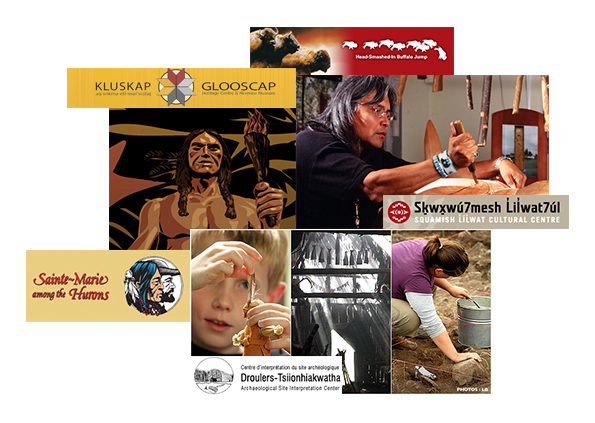Field Trips: Aboriginal Cultural Centres

Prepare your students for the next National Aboriginal Day (June 21) with a visit to a Aboriginal culture centre. Students learn about the cultural of Canada’s various Aboriginal peoples. Many offer games, crafts, and outdoor activities—perfect for releasing some end-of-the-year energy. First Nations governments often operate the centres and may produce resources you can use in your classroom, or have staff that can come and speak to your students about topics like First Nations history or the legacy of residential schools.
Droulers-Tsiionhiakwatha Archaeological Site Interpretive Centre
Saint-Anicet, QC
www.sitedroulers.ca
This full-scale replica of a 15th Century Iroquois village, 75 kilometers from Montreal, gives students the opportunity to immerse themselves in First Nations culture. In addition to guided tours of the village, visits may include lessons about First Nations legends and a game of lacrosse. The educational components are tailored to meet Quebec curriculum for First Nations studies taught in Grade 3 Society classes and high school Canadian History classes. Tours are typically booked a year in advance and are offered in both French and English. The Centre also offers an overnight program where students can stay in the longhouses. The site is usually open from April to October.
Glooscap Heritage Centre and Mi’kmaw Museum
Millbrook, NS
www.glooscapheritagecentre.com
This museum uses multimedia presentations, scavenger hunts, and exhibit tours to teach students about Mi’kmaw history and culture. Teachers can choose additional programming options, including drumming workshops, legend presentations, or specialized talks about specific First Nations issues. These can complement units about First Nations, Mi’kmaw and Canadian history taught in Grades 5, 7, 10, and 11. Centre staff can also visit schools to make presentations about Mi’kmaw culture and First Nations history.
Head-Smashed-In-Buffalo-Jump
Fort Macleod, AB
www.history.alberta.ca/headsmashedin/default.aspx
For thousands of years, Blackfoot hunted buffalo in this area, 90 minutes south of Calgary. Now a UNESCO World Heritage Site, the Jump—a small, elevated landmass—provides students of all ages with opportunities to experience Blackfoot culture. A simulated dig allows them to make their own archaeological discoveries. They can learn about Blackfoot legends while making their own tipi. Students in Grade 4 or older can take guided tours of the trails and the Jump itself. The site also offers a kit teachers can rent for two weeks to teach students about the Blackfoot. Classroom videoconference presentations with site guides are also available.
Sainte-Marie Among the Hurons
Midland, ON
www.saintemarieamongthehurons.on.ca/sm/index.htm
Guided tours of this recreated French Catholic settlement teaches students about some of the earliest interactions between the Huron Wendat people and Europeans. For ten years, in the mid-1600s, French missionaries operated an independent settlement. Conflicts between different First Nations led to the site being abandoned and the Huron Wendat resettling in Quebec. Historical interpreters teach students about First Nations’ customs and the missionaries’ lifestyles. Programs are offered to students of all ages, but the tours particularly fit the Ontario curriculum for Grades 3, 6, and 7.
Squamish Lil’wat Cultural Centre
Whistler, BC
www.slcc.ca
Students have the unique opportunity to learn about both the Squamish and Lil’wat First Nations in one place, surrounded by Whistler’s natural beauty. Trips include guided tours through displays, performances by traditional dancers, and craft-making workshops. The centre also provides educational kits teachers can rent or purchase to use in their classrooms.
Wanuskewin Heritage Park
Saskatoon, SK
www.wanuskewin.com
This is the longest-running active archaeological site in Canada and provides a rare look at how Northern Plains Indigenous peoples lived. Student visitors learn about how bison were hunted and their parts processed to make tools and glue. While hiking the park’s 360 acres of trails, they learn about First Nations’ medicine and history. They can also make their own bannock and tipis. Programs meet provincial curriculum guidelines in subjects like science, social studies, and health. Spots fill quickly, especially during spring. Teachers are encouraged to book their trips early or consider winter programming options.
Woodland Cultural Centre
Brantford, ON
www.woodland-centre.on.ca
This Centre and art gallery, located about one hour west of Toronto, offers students multiple ways to learn about First Nations in Southern Ontario. There are guided museum tours, traditional dance performances, educational scavenger hunts, and craft workshops. Educational programs are tailored for all grade levels, with some trips specifically designed to meet specific Native Studies curriculum expectations. Workshops about the history of the Six Nations of the Grand River and land claims are available. The Centre is also home to the former Mohawk Institute Residential School. Older grades are able to tour the school, sometimes with a school survivor as their guide. The tour may include stories of abuse, or the pain of being separated from families. Because this content may be disturbing, teachers are encouraged to use discretion when booking this tour.
